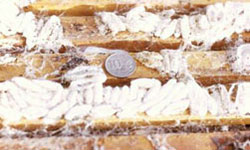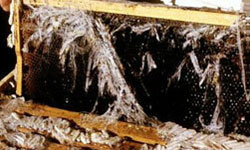
Bee Buzz Box January 2019
Where Rust and Moth Doth Corrupt
Alan Wade
Frontispiece: Wax Moth pupae Victorian Department of Agriculture
Old comb is an easy meal for wax moths. To the beginner or unwary, the wax moth is the ultimate destroyer. Open your stored gear to find a mass of tangled web and pupated moths buried deep into much weakened gear and you will get the message. Any beekeeper who knows the ropes will tell you that wax moth is the dustpan of all abandoned wild and forgotten beehives, the great cleanser and clearer of diseased bee gear.
The truth lies somewhere half way between these maxims. There is some suspicion that wax moths may vector bee pests such as chalk brood. It is also true that the seasoned beekeeper will be occasionally caught out and find his treasured store of dry stickies a parlous webbed mess.
Unguarded bee comb is easy prey to wax moths:
Lay not up for yourselves treasures upon earth, where moth. and rust doth corrupt, and where thieves break through and steal. (Matthew 6:19)
Waxing lyrical on moths
But hang on. There isn’t just one wax moth, there are several:
The Greater Wax Moth, Galleria mellonella, is particularly destructive. It has gained a favourable press in its reputation as an eater of plastic, welcome news to the waste industry. However rest easy: they eat polyethylene products but not the stuff that goes into making plastic frames, plastic foundation and plastic beehives.
The Lesser Wax Moth, Achroia grisella, is often found on combs often in competition with the Greater Wax Moth. In practice it is outcompeted though it is well known for burrowing beneath the cappings of sealed brood where it leaves a characteristic ‘snail trail’. Gently lift the webbing with a hive tool – the white or off white caterpillar will found on the comb surface at the end of the trail. The Lesser Wax moth fares rather better in colder climates but, in competition with the Greater Wax Moth, it is often relegated to scavenging insect fras and wax on the hive floor. Screened bottom boards better ventilate hives and are effective in sifting hive debris attractive to moths.
|
Greater Wax Moth |
Galleria mellonella |
|
Lesser Wax Moth |
Achroia grisella |
|
Bee Moth/ Bumble Bee Wax Moth* |
Aphomia sociella |
|
Fruit Pollen Moth# |
Vitula edmansae |
|
Mediterranean Flour Moth/ Mill Moth# |
Esphestia kuehniella |
|
Indian Meal Moth# |
Plodia interpunctella |
Honey bee moth pests
*Found in both Bumble Bee and European and other wasp nests as well as honey bee combs.
#Pests of stored honey bee products: Fruit Pollen Moth also attack honey bee combs.
Other moths have proved problematic for stored comb materials elsewhere in the world and a few, such as the Bumble Bee Wax Moth and the Fruit Pollen moth have also caused considerable damage to honey bee hives. The Bee Moth and the Indian Meal Moth are both found in Australia.
Keeping the moth at bay
In the apiary: While wax moths may weaken honey bee colonies, they are more a pest than any real threat to bees. Good apiary hygiene – collecting wax and propolis when working hives hives and collecting material from cleaning up hive gear in the shed – will go a long way to preventing establishment of a wax moth reservoir.
In the hive: Strong bee hives headed by young queens, largely free of diseases such as chalkbrood and sac brood virus and with good nutrition will never fall prey to the moth. Bees recognise moths and their larvae and remove them from the hive. In healthy hives wax moth is only ever found in areas not subject to routine patrol, for example between hive mats and frame top bars, in bottom board debris or where too much gear is left on the hive. The 10-20 operating club bee hives have ever only encountered a handful of wax moths over a number of years. Keeping tractable bees that are easy to inspect and maintain and judicious supering practice has made wax moth control a no brainer.

After dinner
Source: Victorian Department of Agriculture (2003). Wax Moth – A Pest of Combs and Honey Bee Products. Note Number: AG1101 http://agriculture.vic.gov.au/agriculture/pests-diseases-and-weeds/pest-insects-and-mites/wax-moth-a-pest-of-combs-and-honey-bee-products
In storage: Never assume old comb is safe in storage. Always treat your gear especially when putting good combs away for winter.
- The simplest option is to freeze combs overnight: this will kill all moth life stages. Don’t leave any gear with wax unattended (foundation is safe) as under warm conditions old comb or even comb with stored honey can be destroyed in a few weeks. Then securely seal them and repeat treatment if a few moths appear. Combs stored in airy spaces with some daylight (wax moths to best in dark confined spaces) and out of reach of rodents can be stored without treatment. Alternatively combs can safely stored below 5 0C but the club at least also doesn’t have the luxury of cool rooms.
Fumigation with carbon dioxide, sulfur dioxide, glacial acetic acid and phosphine (generated from aluminium phosphide tablets purchasable from some stock and station agents) are widely employed, leave no residue but are an occupational hazard if employed in a confined space. Glacial acetic acid, by way of example, is not only an excellent fumigant, killing all life stages of wax moth and Small Hive Beetle, but is also effective in destroying European Foulbrood (Mellisococcus pluton) spores. But though effective, it must be handled with gloves and it will corrode metal fittings, nails and screws if used for longer than needed. For all fumigants, read the material data safety sheet and always work in the open.
Some old treatments, notably using p-dichlorobenzene (PCB, familiar in public urinals) and ethylene dibromide are no longer used because of concern about their toxicity and their leaving residues in wax.
Biological treatments notably spraying dried combs with Bacillus thuringiensis extracts, widely employed to control horticultural pests, have proved ineffectual in killing the Lesser Wax Moth while some formulations are toxic to bees.
Readings
Kwadha, C.A., Ong’amo, G.O., Ndegwa, P.N., Raina, S.K. and Fombong, A.T. (2017). The biology and control of the Greater Wax Moth, Galleria mellonella. Insects, 8, 61, 17pp. doi:10.3390/insects8020061
Somerville, D. (20). Wax moth. PrimeFacts No. 658, NSW Wales Department of Primary Industries. https://www.dpi.nsw.gov.au/__data/assets/pdf_file/0010/176284/wax-moth.pdf

Be the first to comment